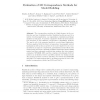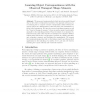IPMI
2003
Springer
15 years 1 months ago
2003
Springer
IPMI
2003
Springer
15 years 1 months ago
2003
Springer
Abstract. The correspondence problem is of high relevance in the construction and use of statistical models. Statistical models are used for a variety of medical application, e.g. ...
IPMI
2003
Springer
15 years 1 months ago
2003
Springer
IPMI
2003
Springer
15 years 1 months ago
2003
Springer
We explore a new paradigm for the analysis of event-related functional magnetic resonance images (fMRI) of brain activity. We regard the fMRI data as a very large set of time serie...
IPMI
2003
Springer
15 years 1 months ago
2003
Springer
IPMI
2003
Springer
15 years 1 months ago
2003
Springer
Most of the approaches dedicated to automatic morphometry rely on a point-by-point strategy based on warping each brain towards a reference coordinate system. In this paper, we des...
IPMI
2003
Springer
15 years 1 months ago
2003
Springer
The recent development of 3-D medical imaging devices has given access to the 3-D imaging of in vivo tissues, from an anatomical (MR, CT) or even functional point of view (fMRI, PE...
IPMI
2003
Springer
15 years 1 months ago
2003
Springer
It is well-known in the pattern recognition community that the accuracy of classifications obtained by combining decisions made by independent classifiers can be substantially high...
IPMI
2003
Springer
15 years 1 months ago
2003
Springer
Abstract. For medical image analysis issues where the domain mappings between images involve large geometrical shape changes, such as the cases of nonrigid motion recovery and inte...
IPMI
2003
Springer
15 years 1 months ago
2003
Springer
Abstract. We propose a learning method which introduces explicit knowledge to the object correspondence problem. Our approach uses an a priori learning set to compute a dense corre...



